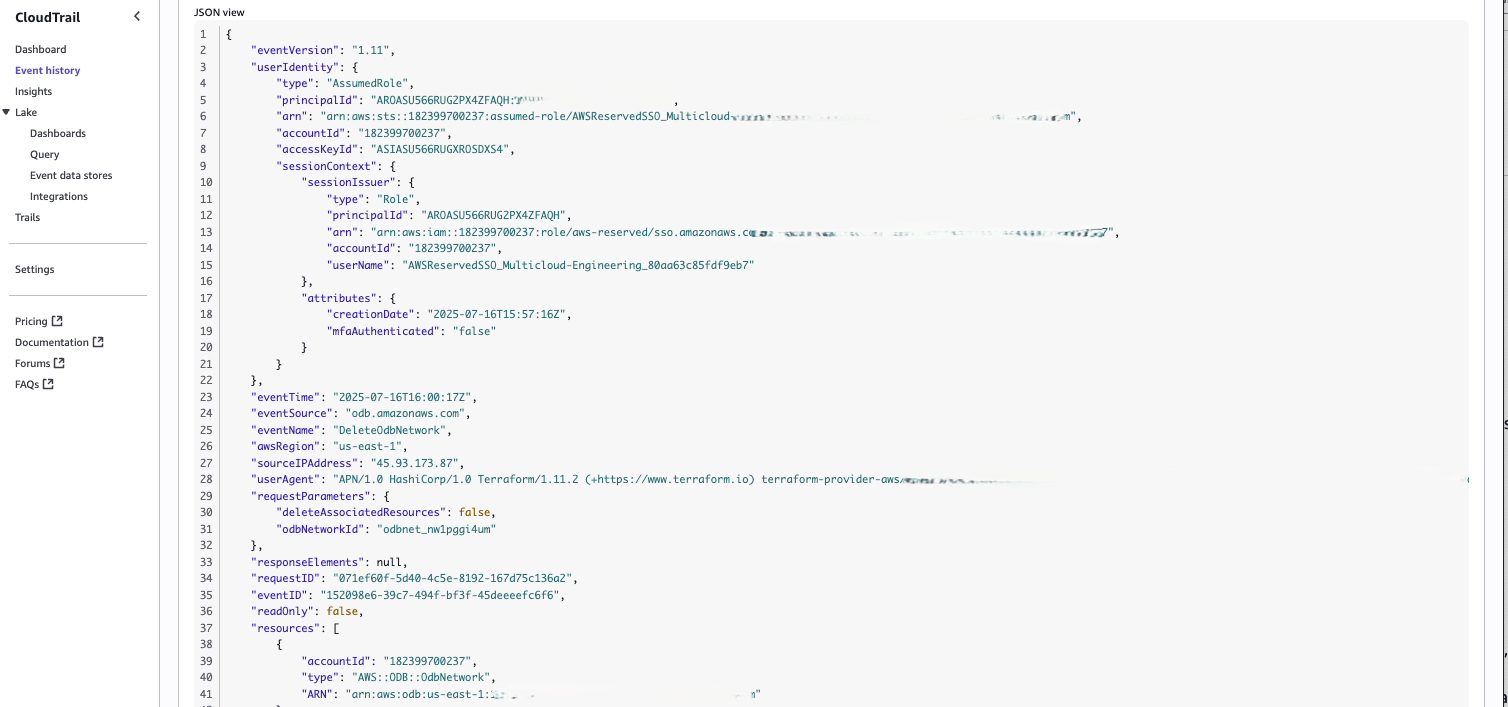CloudTrail
Amazon CloudTrail is a service that enables governance, compliance, operational auditing, and risk auditing of your AWS account.
With AWS CloudTrail, you can record account activity and API usage across your AWS infrastructure, and capture detailed information about every request made to AWS services. These details include who made the request, their source location , and what specific actions were performed. For more information, see What Is AWS CloudTrail?.
Key Components
- AWS CloudTrail allows you to deliver AWS CloudTrail events to an S3 bucket.
- An Event is record of activity in AWS that captures detailed information about every request made to AWS services. These details include who made the request, their source location , source IP address, request and response information.
- Event history provides the ability to view and search events from the past 90 days in the AWS console.
- AWS CloudTrail Lake provides the ability to aggregate, query and analyze activity logs.
- Insights enables you detect unusual operation activity in your AWS account.
Relevance for Database Operations in Oracle Database@AWS
For Oracle Database@AWS, AWS CloudTrail provides the following benefits:
- Tracks the creation and deletion of networks, VM clusters, Exadata Infrastructure, and peering connections.
- Retrieves configuration information for clusters, database nodes, and ODB networks.
- Lists Autonomous VM Clusters, VM clusters, database nodes, database servers, and related resources.
Table 1-6 The list of event names:
| Name | Description |
|---|---|
|
CreateCloudAutonomousVmCluster |
Creates a new Autonomous VM Cluster in the specified Exadata Infrastructure. |
|
CreateCloudExadataInfrastructure |
Creates an Exadata Infrastructure. |
|
CreateOdbNetwork |
Creates an ODB network. |
|
CreateOdbPeeringConnection |
Creates an ODB peering connection. |
|
DeleteCloudAutonomousVmCluster |
Deletes an Autonomous VM Cluster. |
|
DeleteCloudExadataInfrastructure |
Deletes an Exadata Infrastructure. |
|
DeleteCloudVmCluster |
Deletes the VM cluster. |
|
DeleteOdbNetwork |
Deletes an ODB Network. |
|
DeleteOdbPeeringConnection |
Deletes an ODB peering connection. |
|
DeleteResourcePolicy |
Deletes the specified resource policy. |
|
GetCloudAutonomousVmCluster |
Gets information about an Autonomous VM Cluster. |
|
GetCloudExadataInfrastructure |
Gets information about an Exadata Infrastructure. |
|
GetCloudExadataInfrastructureUnallocatedResources |
Gets information about unallocated resources in an Exadata Infrastructure. |
|
GetCloudVmCluster |
Gets information about VM cluster. |
|
GetDbNode |
Gets information about the database node. |
|
GetDbServer |
Gets information about the database server. |
|
GetOciOnboardingStatus |
Returns the tenancy activation link and onboarding status for your AWS account. |
|
GetOdbNetwork |
Gets information about an ODB Network. |
|
GetOdbPeeringConnection |
Gets information about an ODB Perering Connection. |
|
ListAutonomousVirtualMachines |
Lists all Autonomous VMs in an Autonomous VM Cluster. |
|
ListCloudAutonomousVmClusters |
Lists all Autonomous VM Clusters. |
|
ListCloudExadataInfrastructures |
Lists information about the Exadata Infrastructures. |
|
ListCloudVmClusters |
Lists information about the VM clusters. |
|
ListDbNodes |
Lists information about the DB nodes. |
|
ListDbServers |
Lists information about the database servers in the specified Exadata Infrastructure. |
|
ListDbSystemShapes |
Lists information about the shapes that are available for an Exadata Infrastructure. |
|
ListGiVersions |
Lists information about Oracle Grid Infrastructure (GI) software versions that are available for a VM cluster. |
|
ListOdbNetworks |
Lists information about the ODB networks |
|
ListOdbPeeringConnections |
Lists all ODB peering connections. |
|
ListSystemVersions |
Lists information about system versions that are available for VM Cluster. |
|
ListTagsForResource |
Lists information about the tags of the resource. |
|
PutResourcePolicy |
Creates or updates a resource policy that permits other AWS services to send log events to AWS account |
|
UpdateOdbNetwork |
Updates properties of an ODB network. |
For more information, see API Reference.
Search Event Names in CloudTrail
These are the steps to search event names in CloudTrail.
- From AWS console, select CloudTrail.
- From the left menu, select Event history and use the Lookup attributes option to search by Event name.
- The following example demonstrates how to find the user who deleted an ODB network by searching for the DeleteOdbNetwork event within the specified time frame.

- From the Event history list, you can see the list for DeleteOdbNetwork event.

- You can view the detailed information about the event, including the user who initiated the delete request, the source IP address, event ID, and event timestamp. To access these details, click on the event name and review the Event record section for additional information.
